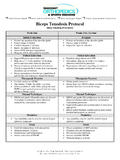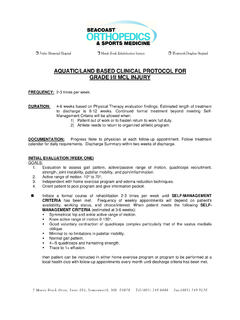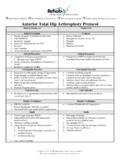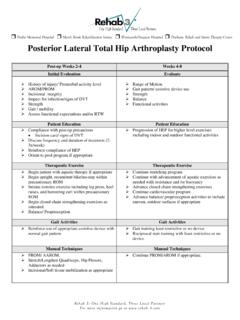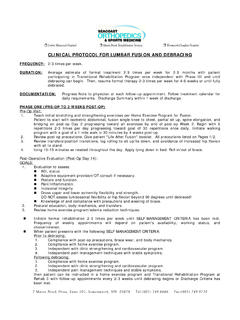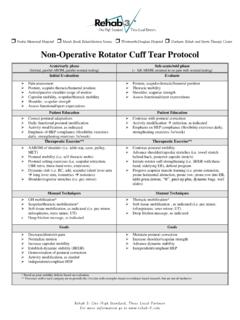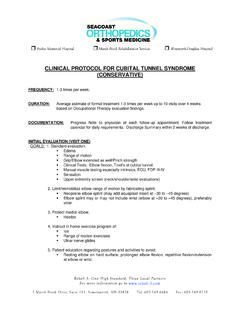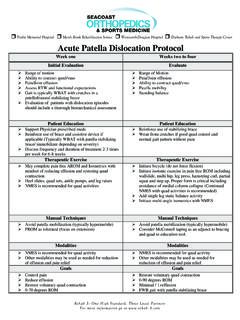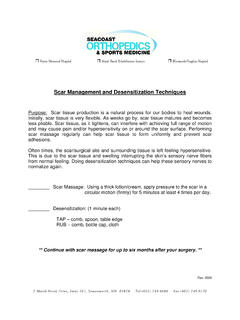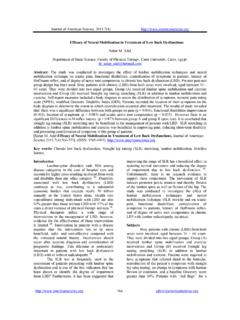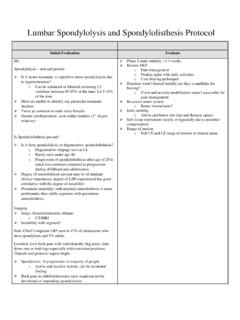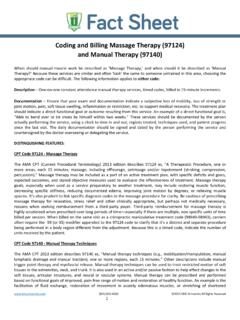Transcription of Post-op Lumbar Laminectomy/Discectomy Protocol
1 Post-op Lumbar Laminectomy/Discectomy Protocol Phase 1 0-4 weeks post Phase 2 4-8 weeks post Initial Evaluation Evaluation Physical Therapy typically to start between 2-4 weeks post depending on age, pain levels and pre surgical functional state Red Flags any signs of infection, worsening weakness and/or radicular symptoms, unexpected increases in pain History to also include presence of previous LE weakness, reflex and sensation changes ROM limiting end ranges, specifically flexion with discectomy Current LE reflexes and strength - Presence of positive LE neural tension signs? Assessment of movement patterns with functional activity such as bed mobility, log rolling, sit to stand transfers ADL/self care status premorbid activity levels Flexibility assess length of quads, psoas, hip rotators and hamstrings Continued assessment of ROM and LE reflexes/strength if changes were initially noted Management of pain medication use Is there a need for thoracic spine treatment use of joint mobilization , manipulation and soft tissue mobilization Evaluate ability to achieve and maintain neutral spine with functional activity such as sitting, standing, squatting, step ups Sleeping positions if having continued difficulty at night Continue to monitor sensation, reflex and strength changes if found during initial evaluation Identify plans for return to work Patient Education Patient Education No bending, lifting or twisting for first 2 weeks.
2 Slowly integrate with proper body mechanics moving forward Limit end ranges of motion, more emphasis on limiting flexion with discectomy No lifting more than 5 pounds first 2 weeks, no more than 10 pounds until 4 weeks Limit sitting for 15 min for first 2 weeks, limit to 30 min (including in a car) until 4 weeks, intermittent standing/walking to limit prolonged sitting Emphasis on upright sitting posture, use of pillows or support if needed Avoid NSAID s, consider smoking cessation program Bracing is typically not needed, however special circumstances will come with MD order Limit lifting to 20 pounds by 6 weeks Limit excessive flexion and rotation with activity, especially with lifting activity Consider changes in ergonomics with return to work Improved sitting posture with prolonged sitting Continue to emphasize on limitation on prolonged sitting, intermittent standing breaks Continue to discuss smoking cessation if needed Therapeutic Exercise/Manual Therapy* Therapeutic Exercise/Manual Therapy* Strong correlation between transverse abdominis (TA)
3 Training and increased muscle size, emphasis on starting TA bracing early in program TA bracing in hooklying, progressing to standing and sitting Walking program emphasis on short durations but increased frequency during the day Emphasis on achieving neutral spine and maintain with functional activity Glute sets Safe stretching of quads, psoas, deep hip rotators and hamstring without placing increased stress to Lumbar spine Continued TA bracing progressing with quadruped, standing and other functional activity (squatting, lunging, etc.) Continued walking program/cardio program If unloaded activity is tolerated better, use of aquatics may be considered Continued soft tissue management along Lumbar and thoracic spine, added use of thoracic manipulation for pain control Performing unloading techniques or use of other pain management strategies Goals Goals Independent with post op precautions Overall decreasing pain levels Independent pain management Correct body mechanics with transfers, bed mobility, log rolling Independent walking program 10 min.
4 2x/day Target date for return to work Able to perform abdominal bracing and maintain with bed mobility activity Continued independent management of pain able to perform active pain relieving techniques such as unloading and LE stretching Independent with correct body mechanics with lifting Ability to maintain neutral spine with activity/HEP 30 min of cardio per day Progressive return to light duty work depending on job type Ability to maintain upright sitting posture with longer sitting References J, Marcus R, Koppenhaver S, Fritz J. Postoperative rehabilitation following Lumbar discectomy with quantification of trunk muscle morphology and function: A case report and review of literature. Journal of Orthopaedic and Sports Physical Therapy. 2010;40:402-412 WC, 3rd, McGirt MJ. An evidence based review of the literature on the consequences of conservative versus aggressive discectomy for the treatment of primary disc herniation with radiculopathy.
5 Spine J. 2009;9:240-257. C, Gao Y, Duchman K, Pugely A. The impact of current smoking and smoking cessation on short term morbidity risk after Lumbar Spine Surgery. Spine 2016;41: 577-584. Phase 3 8-12 weeks post Phase 4 12 weeks + Evaluate Evaluation Assess ability to perform squatting, kneeling, lunges and gentle lifting activity while maintaining neutral spine Ability to maintain lordosis with flexion biased activity Return to work assess postures and body mechanics with lifting activity, ensure safe movement patterns Evaluate for an lingering deficits with ROM, reflexes/strength, flexibility, soft tissue restrictions Need for formal sport training program or other progressive sport related training? Assess ability to maintain neutral spine with recreational/sport related activity Patient Education/Precautions Patient Education Maintaining neutral spine with more advanced strengthening/recreational activity Limiting use of poor gym equipment while transitioning to independent gym/fitness club program Emphasis on continued strengthening/HEP after discharge Avoiding deadlifts and other exercise that incorporates end ranges of Lumbar spine motion Continued importance of continued strengthening/exercise as HEP Therapeutic Exercise/Manual Therapy* Therapeutic Exercise/Manual Therapy* Higher level core training progressive increase in loading exercises while maintaining neutral spine to increase sling leg bridging, use of unsteady surfaces with standing therex, prone strengthening on physioball.
6 Floor to standing training Continued use of manual therapy to thoracic spine and soft tissue management to Lumbar spine if needed Running and other sport related training to begin at 8 weeks post op depending on strength and endurance levels Work simulation training proper mechanics with heavier lifting, ability to maintain neutral spine and abdominal bracing with more dynamic activity depending on job type Any need for continued LE stretching, myofascial techniques and other manual therapy to thoracic/ Lumbar spine? Begin transition to more sport specific training, emphasis on back extensor and abdominals/TA More emphasis on coordination use of changes in speed and direction with plyometric based activity, increased in walking speed/stride length Advanced cardiovascular training Modified abdominal curls, limiting end ranges of flexion Goals Goals Full, pain free Lumbar spine ROM with functional/work related activity Continued ability to maintain neutral spine with all dynamic movement and positions Normal lordosis or reverse lordosis with flexion biased activity Progressing to full duty work Independent with HEP.
7 30 min cardio per day able to progress to longer durations depending on endurance Transition to independent gym/exercise programs Target date for return to sport Able to maintain neutral spine with more advanced strengthening/sport training Ability to recognize activity/exercises that can inadvertently place increased stress and possible injury to Lumbar spine Return to full duty work * Exercises within each category are to provide the clinician with examples based on evidence based research, but are not all inclusive
